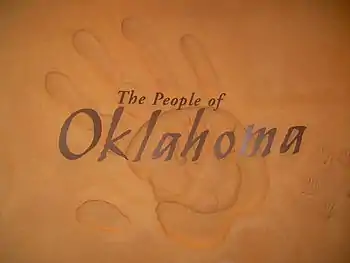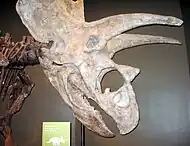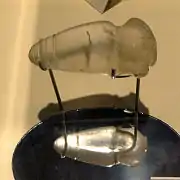Sam Noble Oklahoma Museum of Natural History
The Sam Noble Oklahoma Museum of Natural History is a natural history museum located on the campus of the University of Oklahoma. The museum was founded in 1899 by an act of the Oklahoma Territorial Legislature. Its current building was completed in 1999. The museum contains approximately "7 million objects and specimens in 12 collections."[1] It has almost 50,000 sq ft (4,600 m2) of exhibit space, with five galleries and exhibits that provide an in-depth tour of Oklahoma's natural history. It is "one of the world's largest university-based natural history museums."[2]
.jpg.webp)

Before its 1999 relocation and expansion, the original museum chartered by the Legislature in 1899 had occupied much smaller quarters on campus. It was known as the Stovall Museum of Science & History, named for J. Willis Stovall, a paleontologist and faculty professor who assembled much of the original collection.
Native American languages
The Annual Oklahoma Native American Youth Language Fair is held at the museum every April. In 2013, the fair set a new record for attendance, with 921 Native American language students representing 46 different languages.[3][4] Over 72 languages are held in the museum archives.[5]
The museum holds the Durbin Feeling Collection, named for a Cherokee linguist who published a Cherokee-English dictionary in 1975 and many texts since then on this language and its syllabary. He taught Cherokee for years at the university level. He encouraged the revitalization of the language in the Cherokee Nation and training of new speakers. This collection contains his Cherokee-language materials from years of research, and letters written in Cherokee to and from members of Feeling's family.[6]
Notable specimens
- The world's largest Apatosaurus skeleton.
- The Cooper Skull, a bison skull, found in 1994, is "the oldest painted object in North America."[7]
- A Pentaceratops skeleton with a very large skull that is 3.1 meters high, the largest skull of any known land vertebrate. The skull was excavated in 1941, but was not removed from its rock matrix until 1995. Though some debate exists if the skull is that of a Pentaceratops or the holotype of a different ceratopsian Titanoceratops, the Sam Noble Museum maintains the original Pentaceratops classification.
- A skeletal reconstruction of Saurophaganax, a giant Morrison Allosaurid.
- A number of Mississippian culture stone effigy pipes and other artifacts from the Craig Mound at the Spiro Site.
Gallery



 Crystal boatstone atlatl weight, a Pre-Columbian artifact
Crystal boatstone atlatl weight, a Pre-Columbian artifact
References
- "Collections and Research Division Home". Sam Noble Museum, The University of Oklahoma. Retrieved 2017-06-02.
- "Sam Noble Oklahoma Museum of Natural History - Full Profile of the Sam Noble Oklahoma Museum of Natural History with Hours, Exhibits, Cost and More". About.com. Retrieved 2017-06-02.
- Culver, Galen (2013-04-04). "Great State: Native American Language Fair" (KFOR.com, News Channel 4 ed.). Oklahoma City. Retrieved 2013-04-08.
- Shannon, Susan (2013-04-05). "Native American Youth Language Fair has record attendance". KGOU, Your NPR Source for Oklahoma. Retrieved 2013-04-08.
- "Collections Division, Native American Languages Main Page". Sam Noble Museum, The University of Oklahoma. Archived from the original on 2013-04-04. Retrieved 2013-04-08.
- "Durbin Feeling Collection". Sam Noble Museum. Retrieved August 23, 2020.
- Carter, Brian; Bement, Leland C. (1999). Bison hunting at Cooper site: where lightning bolts drew thundering herds. Norman: University of Oklahoma Press. ISBN 0-8061-3053-9.